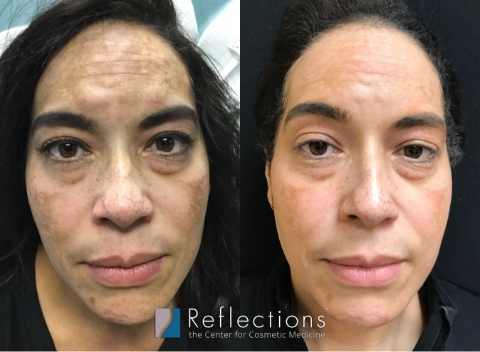Clearing My Melasma with Tranexamic Acid, After Lasers & Rxs Didn’t Work for Me
This patient has been coming to Reflections to manage her melasma for years – and it’s been a real struggle. She has one of the hardest-to-treat cases of melasma we’ve ever seen. It’s been a real struggle to not just remove the pigment, but keep it from coming back. That’s because her melanocytes, the cells that produce melanin (the pigmented cells that create the splotchy brownish-grey patches of discoloration that’s the hallmark of melasma), were working overtime to continually darken her melasma spots – and even when we could successfully remove those irregular melanin cells that had made it to the top layers of the skin (this is how you remove any pigment discoloration, including sunspots, melasma, and hyperpigmentation), there really wasn’t an effective way to stop the melanocytes working deep in the skin from just creating new melanin and sending it up to the surface to replace the ones we had just removed. Most people with melasma aren’t constantly producing new melanin at the rate she was – and that’s why their results from a laser pigment removal treatment would last longer than hers did – but make no mistake, people with melasma are just 1 “triggering event” (such as sun exposure, hormonal fluctuations, or irritation of their skin) away from turning those melanocytes back on, and recreating those dark spots – or even new patches of discoloration.

Like all patients with melasma, the journey to a clear, even-toned complexion has been a bit of a journey for her, and it usually isn’t a one-time journey. Since you cannot cure melasma, there’s always an aspect of management at every life stage for melasma patients – and it’s very likely there will be a need to not just prevent pigment return but also remove and re-treat pigment at some future date. But we have yet to meet a patient whose melasma cannot be improved, even with a limited budget, and tranexamic acid has made that even more true, at a lower cost, and in a more manageable way (at-home medication vs. frequent visits for lasers and aggressive skin exfoliants like chemical peels).
Oral tranexamic acid (prescribed pills) is not the only form of TXA we use. We do take issue with skincare that claims to transport TXA deep enough into the skin to be effective – as there’s been no clinical evidence to support that as a possibility thus far (and it’s critical this chemical actually reach the very deepest part of the skin where melanocytes live to have any impact). However, we also do a treatment called TXA Restore where we microneedle TXA into the skin, so that the patient doesn’t have the systemic impacts of an oral medication. We don’t find traditional microneedling with TXA applied topically to be an effective method of ensuring the right amount of the product actually makes it down those channels the full depth required – and there have been some studies showing those channels in the skin start to close up almost instantaneously.
Related Pages
Tranexamic Acid is not right for everyone, but it is powerful (especially in Rx pill format) for patients with the most stubborn, treatment-resistant melasma.
Our physicians offer free consultations for melasma, so you can learn which treatment options our cosmetic doctors would recommend for you.







